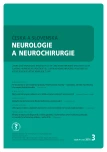Zolpidem in Neurorehabilitation of Minimally Conscious Patient – a Case Report
Authors:
K. Kotková 1; Y. Angerová 1; J. Kořenek 1; K. Kupka 2; O. Švestková 1
Authors‘ workplace:
Klinika rehabilitačního lékařství, LF UK a VFN v Praze
1; Ústav nukleární medicíny, LF UK a VFN v Praze
2
Published in:
Cesk Slov Neurol N 2016; 79/112(3): 347-350
Category:
Case Report
Overview
Neurorehabilitation also has to address the needs of patients in minimally conscious state (MCS). Zolpidem, a short acting non-benzodiazepine hypnotic, has been shown to induce paradoxical responses in some patients with MCS. We assessed zolpidem-induced changes using PET (pozitron emission tomography) in a patient with traumatic brain injury. The patient had PET at baseline and then 24 hours later after administration of zolpidem 10 mg, followed by a radioactive substance. After zolpidem, we observed significantly more intensive activity in the healthy temporal cortex of the right hemisphere. We attempted to utilize this transitory patient activity for training of new skills during a 3-month physiotherapy and occupational therapy programme. However, no development was seen. Similar experience has been described by several authors but they all advocate further research in the mechanism of action of zolpidem and appropriate diagnosis of MCS patients who might profit from its use.
Key words:
minimally conscious state – zolpidem – positron emission tomography – neurorehabilitation
The authors declare they have no potential conflicts of interest concerning drugs, products, or services used in the study.
The Editorial Board declares that the manuscript met the ICMJE “uniform requirements” for biomedical papers.
Sources
1. Giacino J, Ashwal S, Childs N, et al. The minimally conscious state: definition and diagnostic criteria. Neurology 2002;58(3):349–53.
2. Bruno MA, Vanhaudenhuyse A, Thibaut A, et al. From unresponsive wakefulness to minimally conscious PLUS and functional locked-in syndromes: recent advances in our understanding of disorders of consciousness. J Neurol 2011;258(7):1373–84. doi: 10.1007/s00415-011-6114-x.
3. Williams ST, Conte MM, Goldfine AM, et al. Common resting brain dynamics indicate a possible mechanism underlying zolpidem response in severe brain injury. Elife 2013;2:e01157. doi: 10.7554/eLife.01157.
4. Thonnard M, Gosseries O, Demertzi A, et al. Effect of zolpidem in chronic disorders of consciousness: a prospective open-label study. Funct Neurol 2013;28(4):259 – 64. doi: 10.11138/ FNeur/2013.28.4.259.
5. Whyte J, Myers R. Incidence of clinically significant responses to zolpidem among patients with disorders of consciousness: a preliminary placebo controlled trial. Am J Phys Med Rehabil 2009;88(5):410–8. doi: 10.1097/PHM.0b013e3181a0e3a0.
6. Chatelle C, Thibaut A, Grosseries O, et al. Changes in cerebral metabolism in patients with a minimally conscious state responding to zolpidem. Front Hum Neurosci 2014;8 : 917. doi: 10.3389/fnhum.2014.00917.
7. Calabresi P, Centonze D, Bernardi G. Cellular factors controlling neuronal vulnerability in the brain: a lesson from the striatum. Neurology 2000;55(9):1249–55.
8. Schiff ND. Recovery of consciousness after brain injury: a mesocircuit hypothesis. Trends Neurosci 2010;33(1):1–9. doi: 10.1016/j.tins.2009.11.002.
9. Pistoia F, Sara M, Sacco S, et al. Silencing the brain may be better than stimulating it. The GABA effect. Curr Pharm Des 2014;20(26):4154–66.
Labels
Paediatric neurology Neurosurgery NeurologyArticle was published in
Czech and Slovak Neurology and Neurosurgery

2016 Issue 3
- Metamizole vs. Tramadol in Postoperative Analgesia
- Metamizole at a Glance and in Practice – Effective Non-Opioid Analgesic for All Ages
- Memantine in Dementia Therapy – Current Findings and Possible Future Applications
- Memantine Eases Daily Life for Patients and Caregivers
- Hope Awakens with Early Diagnosis of Parkinson's Disease Based on Skin Odor
Most read in this issue
- Sympathetic Chain Schwannoma – a Case Report
- Validity Study of the Boston Naming Test Czech Version
- Clinical Guideline for the Diagnostics and Treatment of Patients with Ischemic Stroke and Transitory Ischemic Attack – Version 2016
- Pre-motor and Non-motor Symptoms of Parkinson’s Disease – Taxonomy, Clinical Manifestation and Neuropathological Correlates
